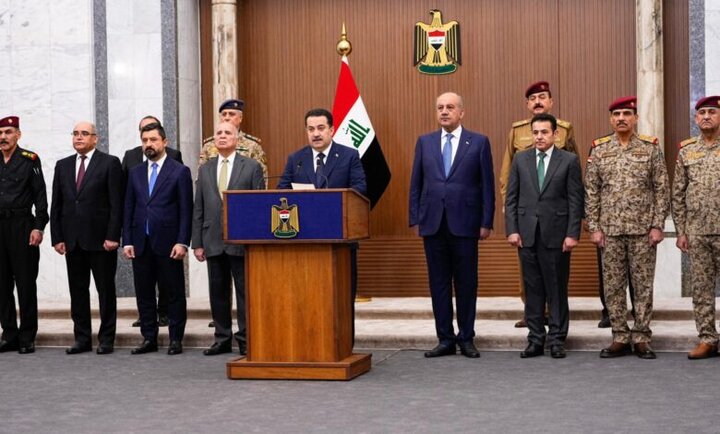Benefits, Challenges, and Prospects of Iraq’s New National Security Document.
According to Middle East News, at first glance, the Iraqi National Security Strategy (2025-2030), titled “Iraq First,” appears to be a comprehensive and ambitious document that attempts to respond to Iraq’s multifaceted challenges. However, like any other strategic plan, this strategy can also have prospects, challenges, and potential strengths and weaknesses.
Prospects and Advantages of the Iraqi National Security Strategy
This strategy’s comprehensiveness and holistic approach are among its advantages because it is not limited to military and security aspects but also includes economic, social, diplomatic, religious, and service dimensions. Adopting such a comprehensive approach is essential for a country like Iraq that faces complex and intertwined challenges.
The emphasis on internal and external partnerships is among other advantages of this strategy; The participation of all government institutions, civil society, and the support of international organizations in the development and implementation of this strategy, as the Iraqi Prime Minister himself has also stated and has appreciated the support of the European Union Advisory Board and international organizations, indicates an effort to create consensus and utilize the diverse capacities of Iraqi society, and refers to the support of the European Union and international organizations, which can lead to attracting technical and financial assistance.
Choosing the name “Iraq First” for this strategy indicates a focus on Iraq’s national interests and placing these interests at the top of the priorities, which can help increase national solidarity, while setting a long-term five-year timeframe and horizon can help plan, follow up, and evaluate progress.
The Iraqi Prime Minister’s emphasis on public responsibility and the participation of all segments of society and institutions for the success of this plan can help increase its participation and ownership.
Challenges and Problems
One of the biggest challenges for any strategy in Iraq is its implementation, because, according to many experts, Iraqi society faces deep-rooted challenges such as administrative corruption, political instability, the influence of armed groups, and the weakness of organizations and institutions. Although drafting a good and comprehensive document is considered an important and good issue, its implementation in practice will be something else.
It can be said that another weakness of this document is the lack of reference to details and implementation mechanisms, so that the published text refers more to general objectives and less to details and methods of implementation and key indicators, and this issue will make it difficult to assess the success or failure of this plan.
Another issue that can be mentioned in the context of the challenges of this plan is the problem of maintaining balance and equilibrium in the face of regional and international influence. Although this strategy emphasizes the creation of balanced and balanced international partnerships, the reality is that Iraq will have a very difficult time managing regional and international influence, given its strategic location in the heart of the Middle East and its common borders with Iran, Turkey, Syria, Saudi Arabia, Kuwait, and Jordan, its possession of one of the world’s largest oil reserves, its religious and ethnic diversity, the existence of threats such as terrorism, and the political, economic, military, cultural, and religious influence of various actors.
As an analogy, it can be said that Iraq must be able to continuously balance, like a professional ballerina or, better said, a diplomatic dance, between the need for cooperation and assistance on the one hand and maintaining independence and sovereignty on the other. It should be noted that the success of this strategy is largely related to Iraq’s ability to diversify its foreign relations and strengthen its domestic institutions, which are vital for Iraq’s long-term stability.
Another challenge facing the implementation of this strategy is the issues surrounding the development and integration of Iraq’s security and defense sectors. While the new national security strategy emphasizes strengthening this system, the realities in Iraq pose major challenges to this goal.
Although the Iraqi government is strongly seeking to integrate and integrate the structure of the country’s security and defense forces, including the army, federal and local police, the Kurdistan Regional Government’s Peshmerga forces, and the Popular Mobilization Forces, it faces a difficult path in this direction.
However, only in the case of the Popular Mobilization Forces and other resistance groups, after the unfounded rumor of US President Trump’s pressure to disband this force and Faleh Al-Fayyadh’s recent statements that the law on the Popular Mobilization Forces had been approved by the Iraqi cabinet and was being reviewed by parliament, there was a strange sensitivity among media, political, and military circles.
In this regard, some media circles hastily interpreted Al-Fayyadh’s words as equivalent to terms such as the integration or relative independence of the Popular Mobilization Forces, and some went further than that and spoke of the dissolution of this force under the command of the General Command of the Iraqi Armed Forces. However, the new law of the Popular Mobilization Forces is considered an important development in the security and political structure of Iraq. Based on this law, not only will the position of the Popular Mobilization Forces not be weakened, but there will be a significant improvement in its situation in terms of organizational structure, powers, duties, and capabilities. As Al-Fayyadh has stated, “The approval of the law related to the Popular Mobilization Forces in the House of Representatives will place this organization on the right path and in its rightful place within the military institution, while this law will also include the construction of a military academy for the Popular Mobilization Forces.”

